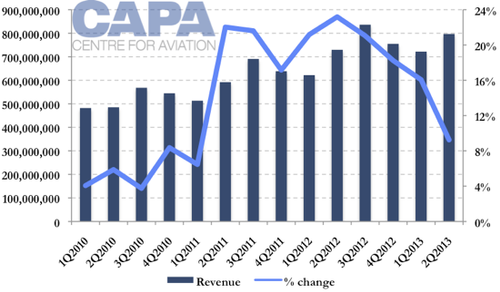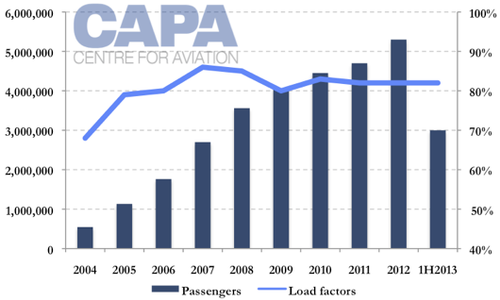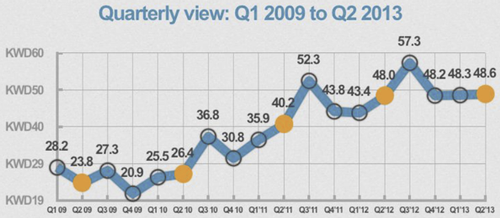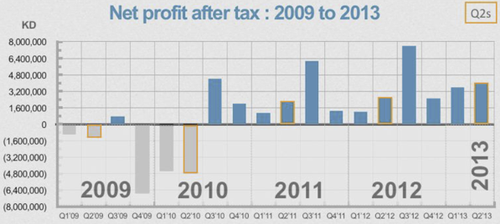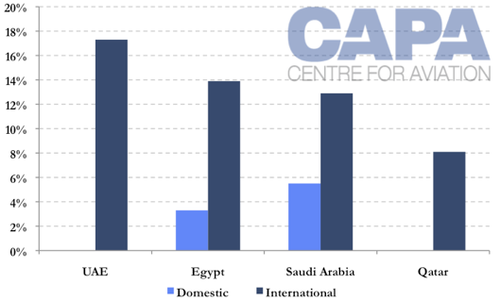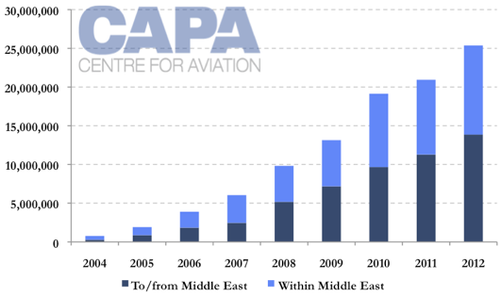Middle East low cost airlines report a profitable start to 2013
Regional political uncertainty and social turmoil have not been able to stop low-cost carriers in the Middle East from reporting another profitable six months. Two of the region's key privately owned LCCs, the Sharjah-based Air Arabia and the Kuwait-based Jazeera Airways, have both posted strong profits in 1H2013.
In addition to this, the region's other two LCCs, the privately owned nasair and the emirate of Dubai-controlled flydubai are anticipating profitable full year results. flydubai reported a maiden profit in 2012 and is looking to continue this momentum into 2013.
nasair has not yet reported a break-even year, despite being launched in 2007, but a restructuring in late 2012 has already seen the carrier reporting profits on a monthly basis.
Air Arabia reports positive first half, but load factors are falling
Air Arabia, the Middle East's largest and oldest LCC, reported a 1H2013 profit of AED134.3 million (USD36.6 million). Air Arabia reported revenue of AED1518.5 million (USD414 million) in 1H2013, up 19% compared to the first half of 2012. The carrier's chairman, Sheikh Abdullah Bin Mohammed Al Thani said the result was a "strong and solid financial performance despite on-going political turmoil in parts of the region, which continues to impact the transport sector and the regional economic growth."
Air Arabia revenue (AED): 2010 to 2Q2013
Passenger numbers were up 16%, with the airline handling over three million passengers in the first six months of the year, compared to the 2.6 million passengers handled in 1H2012. 2Q2013 traffic was just under 1.6 million passengers, up 17%.
Air Arabia passenger traffic and passenger load factor: 2004 to 1H2013
Average load factors for the first half of the year were 82%, but have slipped somewhat in the year-on-year comparison, as the company has expanded its fleet of A320s to 33 in the quarter, expanding capacity ahead of demand. Air Arabia took delivery of three aircraft from Airbus this year, including the Middle East's first Airbus 'sharklet' equipped A320 aircraft. The carrier's 2Q2013 capacity expanded 20.4%, to 3.89 billion ASKs, while RPKs grew by 17.3%, to 3.2 billion.
The easing puts Air Arabia's load factors in line with the industry average across the region. However, the carrier's 13 hour per day aircraft utilisation and 99.6% operational reliability mean that it still has region-leading asset utilisation. It also boasts an industry-leading average head count of just 53 employees per aircraft.
Air Arabia's strategy involves capitalising on its multi-hub model to access key emerging regions, penetrating new markets and growing its overall network. With hubs in Sharjah, Morocco and Egypt, the carrier connects much of the Arab world with Europe, Asia and Africa. During 1H2013, Air Arabia added five new routes from Sharjah: Baghdad, Abha, Ha'il and Yerevan in Armenia.
According to Sheikh Abdullah, the carrier intends to continue to focus on its business expansion strategy, "which will enable us to launch new services and enter new geographies in the coming six months". Air Arabia is well capitalised enough that it can rapidly exploit market opportunities.
The airlines had AED1.33 billion in cash reserves at the beginning of 2013 and will take advantage of the current low interest rate environment to partially finance its new aircraft purchases. Its supporting businesses and joint ventures, including flight services, ground handling, information technology and hotel operations, are all contributing positively to its bottom line.
Jazeera Airways reports record 1H2013 profit
Jazeera Airways is also enjoying record profits in the growth conditions. The airline handled million passengers in 1H2013, an increase of 4.1% reflecting the more subdued nature of the Kuwait aviation market and a reduction in flying by Jazeera Airways, due to the dislocation resulting from the Syrian civil war. However, the carrier also reported an average passenger load factor of 70%, up from 63% in the same period last year. While this is well below that of Air Arabia, and other LCCs in the region, it is also well ahead of the carrier's own load factor targets under its STAMP medium-term strategic plan.
With record load factors, the airline has been able to continue the upward run of yield levels. Passenger yield reached 48.6 Kuwaiti fils per passenger in the first six months of the year, an increase of 6.1% on the same period in 2012. Yield improvement was only 1% in 2Q2013, the most sluggish increase since the launch of the carrier's turn around programme in 2010.
Jazeera Airways quarterly yields: 1Q2009 to 2Q2013
Jazeera Airways anticipated improving yield levels will continue to get more difficult, with most of the easy ground in cost and yield management already covered and competition in Kuwait sustaining the market's overcapacity. Yield levels for 2H2013 are expected to improve, with the carrier forecasting stronger demand in 3Q2013 and 'mild' demand in 4Q2013.
Jazeera Airways' 1H2013 revenue was KWD30.8 million (USD million), up 9% compared to the same period in 2012. With the increasing passenger yields, operating profit reached KD 9.5 million (USD million) up to 48%, an impressive operating margin of 35%. Net profit was KWD9.5 million, an increase of 95% over 1H2012.
Jazeera Airways net profit (after tax): 2009 to 2013
In Jun-2013, Jazeera Airways took delivery of the 13th A320 of the 15 it has ordered. The Jazeera Airways operating fleet now stands at seven aircraft, with the older A320s leased out through the group's Sahaab Leasing unit. During 4Q2013, Sahaab placed an A320 with nasair, making the Saudi Arabian LCC the company's fourth customer. Sahaab Leasing contributed 28% of the group's operating profit in 1H2013, and approximately 25% of its revenue.
Two more A320s are due to be added to the Jazeera Group's fleet, one in 2H2013 and one in May-2014. Beyond that, the carrier's fleet plans have not been finalised, although it plans to issue a request for proposals to manufacturers by 4Q2014. Leasing aircraft to meet expanding demand may be a short-term option for the airline in 2014.
For 2H2013, Jazeera is focusing on rigorous cost management, maximising the potential of the peak summer travel period - historically responsible for nearly 50% of the carrier's annual profits - and improving frequencies across its network. Jazeera is not looking at adding new destinations, instead concentrating on improving operational efficiency and aircraft utilisation, as well as enhancing attractiveness to tourist and business travellers. The carrier's outlook for 2H2013 is for continued profitability, in line with a growing Kuwaiti economy.
LCCs revelling in a growing market
Despite some localised regional unrest, overall market conditions in the Middle East have been beneficial for low-cost carriers in 2H2013. Oil prices have stabilised, local economies are growing and regional travel and tourism is expanding thanks to expanding incomes and an increasing propensity to travel. Regional tourism markets are also expanding, benefiting from the heavy investment by regional governments over the past decade.
As a result, the Middle East's point-to-point market is seeing significant pick-up in passenger demand this year. The Arab Air Carriers Organization reports that international traffic within the Arab world has sustained double-digit growth rates over 1H2013, after an uneven end to 2012.
Arab world passenger traffic growth
Passenger demand growth remains ahead of the increase in capacity, despite the rapid increase in fleet size by both LCCs and the major network carriers in the region. Business confidence across most of the Middle East remains high, thanks to the continued high price of oil, growing local economies and the expansion of trade in the region.
With demand outgrowing supply, load factors and yields have been rising in the region. This lead IATA to revise its 2013 profit outlook for the region's airlines to USD1.5 billion, well up from the USD900 million profit recorded in 2012. Profit margins in the Middle East are expected to be around 3.5%, close to double the forecast global average profit margin of 1.8% for the year.
According to IATA, passenger demand in the Middle East is expected to continue to expand at around 15%, well ahead of the anticipated 12.6% capacity expansion.
Middle East ASKs (capacity) and RPKs (demand)
According to Amadeus, approximately 50% of routes within the Middle East are either monopoly or duopoly operations. This leaves significant opportunity for LCCs to continue to expand. Middle East LCCs have made inroads into some of the most significant regional point-to-point markets, making up a quarter of all traffic on the region's two busiest routes - Dubai-Doha and Jeddah-Riyadh - and better than 50% of seat capacity on the Dubai-Kuwait route.
Top 15 Middle East regional routes and LCC market share: week to 08-Aug-2013
|
Rank |
Route |
Total seats |
LCC market share |
|---|---|---|---|
|
1 |
Dubai-Doha |
85,896 |
26.84% |
|
2 |
77,303 |
24.92% | |
|
3 |
62,287 |
50.71% | |
|
4 |
54,988 |
32.61% | |
|
5 |
49,092 |
29.54% | |
|
6 |
35,770 |
25.36% | |
|
7 |
32,476 |
31.43% | |
|
8 |
Doha-Bahrain |
31,399 |
4.21% |
|
9 |
29,241 |
10.40% | |
|
10 |
24,923 |
0.00% | |
|
11 |
Riyadh-Abha |
23,293 |
7.39% |
|
12 |
22,940 |
0.00% | |
|
13 |
21,686 |
41.83% | |
|
14 |
21,594 |
0.00% | |
|
15 |
21,330 |
31.90% |
However, LCCs remain notably absent from some of the region's largest routes as well. No LCC operates within Iran and the demise of Bahrain Air in 2012 has left routes to/from Manama underserved in terms of LCC capacity.
Regional LCCs have also been involved in developing new markets to/from the Middle East. The low-cost model has been instrumental in pioneering new routes into Eastern Europe, Central Asia, Southern Asia and Africa. However, low-cost carrier penetration in the market remains limited, accounting for approximately 13.5% of all seats offered in the region. A few key markets, most notably the UAE, Egypt and Saudi Arabia, account for the majority of LCC operations. Several of the Middle East's largest travel markets, such as Qatar and Saudi Arabia, show LCC penetration rates lower than 10%.
Selected Middle East countries by LCC penetration (domestic and/or international markets)
There are still some downside risks in the market for LCCs. The Syrian conflict has forced Air Arabia and Jazeera Airways to manage the disruptions to their networks. Both carriers have ended services to Syria and have also periodically redeployed capacity to deal with more temporary disruptions in Lebanon and Egypt.
Low-cost airlines generating big profits in the Middle East, but more ground to cover
The Middle East has become increasingly fertile ground for low-cost airlines to extract profits. Air Arabia, Jazeera Airways and flydubai all reported profitable 2012s and have experienced positive starts to the year. nasair is not in the black just yet, but the carrier's objective for 2013 is to report its maiden break-even year and so far its performance has been encouraging.
The low-cost model is now well established in the Middle East. The region's LCCs continue to expand at a faster pace that the rest of the region, introducing aircraft and destinations with astonishing speed.
In a decade, the low-cost market has gone from zero to 9.4% of international seats offered to/from the region and 15.8% of seats within the region.
Middle East LCC seats to/from and within the region
However, despite the success of the LCCs in the region in developing new markets and growing their operations, the region lags much of the rest of the world in terms of the maturity of its LCC market. In Europe and North America, LCCs have around 30%; in Asia-Pacific it is approaching 50%.
There are a number of countries in the Middle East ripe for LCC penetration, provided that governments in the region are willing to liberalise and subject their state-owned national carriers to intensified local competition. The UAE and Kuwait have lead the way, either launching state-owned LCCs of their own or allowing private operators into the market.
Other countries have proved either unwilling to liberalise or have gone backwards after initially allowing LCCs into the market, such as in the case of Bahrain. The barriers to entry and protectionist regimes in aviation markets in Jordan, Iraq, Qatar, Lebanon and Oman have either prevented LCCs from entering or limited the exposure of national carriers by creating uneven competitive playing fields.
The need for liberalisation is growing, as travel intentions blossom
The Middle East market is due for greater LCC development. With young populations, a high level of personal mobility and growing disposable income, the propensity to travel within the Middle East is growing. A few nations are beginning to heed the lessons from other developing markets such as Asia and South America where LCCs have been the major engine for traffic growth.
Oman may be the first to move. The country's aviation authorities are now considering awarding an operating licence for a low-cost carrier, to either a local Omani private company or Oman Air, via a dedicated subsidiary of the national carrier. In Mar-2013, Oman Air chairman Darwish bin Ismail Al Balushi confirmed that in principle approval has already been granted for a low-cost unit, and a feasibility study was underway.
Jordan is also set for a new, private LCC to enter the market. In Jan-2013, Petra Airlines received regulatory approvals to operate as a scheduled carrier, in order to become the country's first LCC. With the end of Royal Jordanian's monopoly rights, the carrier intends to jump on the opportunities being presented in Jordan to benefit from the country's open-sky policy, particularly to provide links with Saudi Arabia and EU states. The carrier's CEO, Riad Khashman, has announced that the airline is looking to partner with a major, established low-cost carrier to hasten its transition from a charter carrier into a LCC. In May-2013, it signed an agreement with Lufthansa Consulting for advisory services.
In addition to Petra Airlines, Air Arabia is still keeping alive its plan to establish its fourth hub in Amman. The carrier plans to use the Levant base to further grow its existing global network and broad range of links between the Arab world and Europe. Major European hubs such as Paris, Frankfurt, Munich, Amsterdam and Rome are within A320 flying range of the Jordanian capital.
Carriers continue to express frustration at the slow pace of liberalisation within the regional market, as well as to some other major markets such as India, but there is still plenty of growing room for LCCS in the Middle East. The upside will be a win-win for travellers, airlines and national economies alike.
